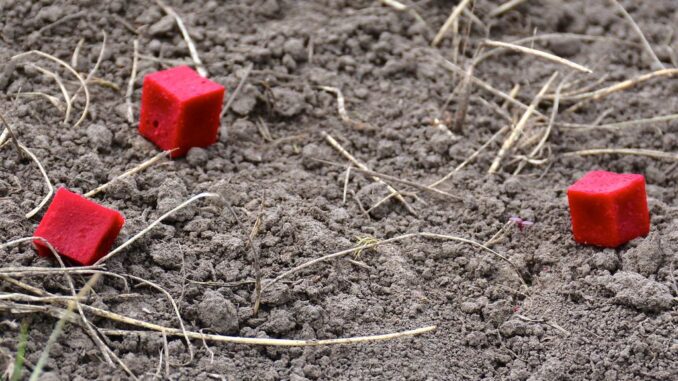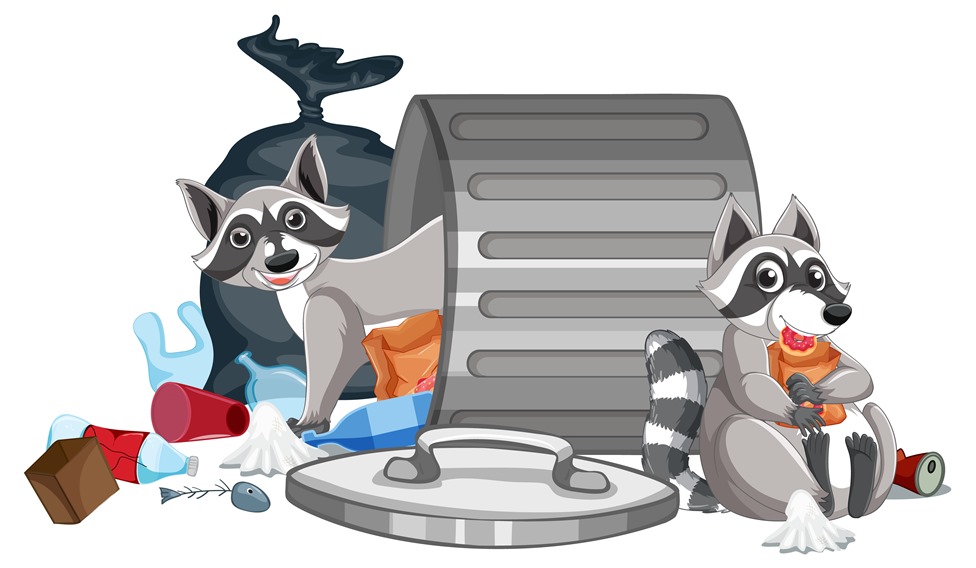
Raccoon bait refers to food that is used to attract and lure raccoons. The main purpose of raccoon bait is for trapping or hunting raccoons. There are several popular types of bait that are commonly used:
- Fruit – Raccoons have a sweet tooth and love fruits like apples, grapes, cherries, and berries. Fruit makes an enticing bait.
- Meat – Slices of hot dogs, fish, chicken, bacon, or canned cat food are tasty meat baits for raccoons. The strong smell appeals to their scavenging nature.
- Marshmallows – Surprisingly, raccoons cannot resist marshmallows. The soft sweetness is very appetizing.
- Peanut butter – Sticky peanut butter is hard for raccoons to ignore. It coats their mouth and is full of protein.
- Pet food – Any type of cat or dog food, especially the soft and smelly kind, makes great bait for raccoons.
The key is to use bait that is aromatic and tasty to raccoons. The bait should trigger their powerful sense of smell and appetite to draw them in. Popular choices are food items high in protein or sugar.
Table of Contents
Making Your Own Raccoon Bait
Making your own raccoon bait at home provides a number of benefits compared to buying commercial baits. You can customize the bait to be more enticing to raccoons in your area, control exactly what ingredients are used, and save money by using ingredients you likely already have at home.
Some common homemade raccoon bait recipes include:
- Canned fish-based baits like sardines, tuna, or cat food mixed with marshmallows, jelly, or maple syrup to add sweetness and stickiness.
- Sweet baits like jam, jelly, maple syrup, or honey spread on bread, pastries, or dried fruit.
- Meat or fish scraps mixed with peanut butter, pet food, or bacon grease.
- Leftover cooked meat mixed with molasses, jelly, or fruit.
- Hard-boiled eggs covered in syrup, jelly, or bacon fat.
The main ingredients needed for homemade raccoon bait are:
- A fish, meat, or egg base to provide protein. Canned fish, meat scraps, bacon grease, eggs, and leftover cooked meat work well.
- A sticky sweetener like marshmallows, jelly, jam, honey, maple syrup, or corn syrup.
- Some oil or fat like peanut butter or bacon grease to provide scent.
You’ll also need some simple equipment:
- Mixing bowl
- Spoon or whisk
- Bait container like a plastic tub, jar, or reusable plastic bag
The benefits of crafting your own raccoon bait include saving money, controlling ingredients, and customizing it to your specific needs. With just a few inexpensive household ingredients and items you likely already have, you can make bait raccoons can’t resist.
Commercial Raccoon Baits
Commercial raccoon baits provide a convenient alternative to making your own homemade bait recipes. There are a variety of premade bait options available for purchase at many hunting and trapping supply retailers.
Some popular commercial raccoon bait products include:
- Marshmallows – Sweet and sticky, marshmallows make excellent bait for raccoons who have a sweet tooth. They are inexpensive and easy to find. However, they may also attract other animals.
- Sardines – Sardines packed in oil create an irresistible scent trail for raccoons to follow. Make sure to choose sardines without added spices. Canned fish can be messy though.
- Loganberry treats – These commercial baits contain loganberry flavoring which raccoons seem to love. They often come in a round puck shape with a hole in the center to place on your trap.
- Sugared cereals – Cereals like Frosted Flakes that are coated with sugar make great bait for raccoons. The key is finding cereals with higher sugar content.
The main advantage of commercial baits is convenience – they are premade so you don’t have to mix up any homemade recipes. Commercial baits like Loganberry treats are designed specifically to be irresistible for target animals like raccoons.
However, homemade baits allow you to customize the ingredients to create a scent raccoons can’t refuse. Homemade baits may also be more budget-friendly over time.
Commercial raccoon baits can be found at many large retailers that carry trapping supplies including Cabela’s, Bass Pro Shops, and Tractor Supply. You can also find a wide selection of baits at online retailers like Predator Control Group or F&T Fur Harvester’s Trading Post. Make sure to choose fresh bait that isn’t expired.
How to Set Up and Use Raccoon Bait
When setting up raccoon bait, it’s important to choose the right location to maximize your chances of attracting raccoons. Here are some tips for setting up a bait station:
Tips for Choosing a Bait Site
- Look for areas with obvious raccoon activity like dens, latrines, and tracks. Setting up near their nesting and feeding areas increases the chance they’ll find your bait.
- Focus on secluded, quiet areas away from human activity. Raccoons are nocturnal and shy so they prefer isolated sites.
- Areas near water sources like ponds, streams, and swamps are ideal as raccoons frequent these habitats.
- Look for natural corridors like fallen trees, drainage pipes, and culverts which raccoons use to travel. These make good bait locations.
- Consider elevated areas like stumps, fallen logs, large rocks, and branches which allow raccoons to spot bait while feeling secure.
How to Set Up a Bait Station
- Choose an appropriate bait such as canned fish, cat food, chicken, or corn. Something smelly and enticing works best.
- Place the bait in an open area, not too close to bushes or trees where predators may lurk.
- Optionally, you can place bait inside a small box or pipe with both ends open. This protects from other animals.
- Check local regulations, as some baits like meat or fish may be prohibited if they attract bears.
- Secure the bait station if possible so it can’t be dragged away. Raccoon-proof fasteners are ideal.
- Set up game or trail cameras to monitor activity at the station if desired.
Strategies to Attract Raccoons
- Establish a regular feeding schedule, such as baiting every 2-3 nights around dusk. Raccoons will learn to return more reliably.
- Apply bait or scent lures like fish oil, anise, or vanilla to attract raccoons from further away.
- Use movement and sounds to grab their curiosity. Shiny objects that sway in the wind or crinkly items work well.
- Be patient and consistent. It may take a week or more for raccoons to regularly visit your bait site.
By following these tips, you’ll be able to successfully set up a bait station that maximizes your chances of attracting raccoons while keeping the site safe and secure. Check regulations in your area before baiting.
Laws and Regulations
Raccoon baiting is regulated in most areas, so it’s important to be aware of the laws and obtain any required permits or licenses. Here’s an overview of some common regulations:
- Many states require a trapping or hunting license to bait raccoons, even if you don’t intend to trap or hunt them. Some states may have specific “nuisance animal” permits for raccoons. Check your state’s department of natural resources website for details on licensing.
- There are often restrictions on what types of bait can be used. Meat and food waste baits are typically allowed. Scents and lures are usually fine too. However, it’s generally illegal to use poisons or hazardous materials.
- Baiting raccoons on public lands is usually prohibited without a special permit. Make sure you place bait only on private property where you have permission.
- Some municipalities don’t allow baiting at all within city limits, or may restrict it to certain seasons. Check for any local ordinances in your area.
- It’s advisable to inform your neighbors if you plan to bait raccoons nearby, in case it draws raccoons onto their property as well. There may be rules about proximity of baiting sites to dwellings.
- Certain types of traps and snares cannot be used, or require additional permits. Make sure you know the laws on capture methods. Baiting alone is not restricted.
- Any captured raccoons must be handled and released or euthanized humanely according to your state’s laws. It’s illegal to relocate and release them elsewhere.
In summary, check all federal, state and local regulations thoroughly before placing any raccoon bait. It’s a good idea to contact your state wildlife agency to ensure you follow all required rules and get any necessary permits or licenses. Responsible baiting requires knowledge of the applicable laws.
Ethical Considerations
When using bait to attract raccoons, there are some important ethical considerations to keep in mind.
Animal Welfare Concerns
Raccoons are intelligent, sentient animals capable of suffering. Luring them with bait solely for human benefit raises animal welfare concerns. Raccoons attracted to bait may become trapped, injured, or killed. Using bait should be avoided unless truly necessary.
Risks to Pets and Children
Baiting raccoons can also endanger pets and small children. Raccoons may become aggressive around bait. Pets attracted to the bait may get into conflicts with raccoons and become injured. Children could also be bitten or scratched. Supervise children and pets closely if baiting raccoons.
Promoting Coexistence
Rather than baiting, focus on removing attractants like trash and pet food that draw raccoons to properties. Secure lids on trash cans and feed pets indoors. This promotes coexistence with wildlife. Only use bait as a last resort if raccoons pose a direct threat. Focus on prevention first through humane exclusion and removing attractants.

Safety Precautions
When using raccoon bait, it’s important to take safety precautions. Raccoons can potentially carry diseases, so you’ll want to avoid direct contact with them or their feces. Here are some tips for handling raccoon bait safely:
- Wear thick gloves when handling bait to avoid accidental scratches or bites. Raccoons may bite if startled.
- Set up bait stations that prevent raccoons from accessing the bait directly. For example, place bait at the end of a pipe or in a cage trap.
- Avoid areas with obvious raccoon feces, as this can indicate the presence of raccoon roundworm, which can cause serious illness in humans.
- Wash your hands thoroughly with soap and hot water after handling bait.
- Dispose of uneaten bait and wash all equipment used to distribute bait. Uneaten bait can harbor bacteria.
- Get necessary pre-exposure rabies vaccinations if you’ll be regularly handling wildlife bait. While rare, raccoons can carry rabies.
- Supervise children and pets around areas baited with raccoon bait. Don’t allow them access.
- Wear a face mask if cleaning areas with raccoon feces to avoid inhaling particles that could contain roundworm eggs.
Raccoons can be unpredictable wild animals, so baiting does involve some degree of risk. Following safety precautions will help minimize the chance of injury or illness when baiting for raccoons.
Troubleshooting Tips
Raccoon baiting can be tricky and there are a few common issues that may arise:
Raccoons not taking the bait – If raccoons don’t seem interested in your bait, try changing the type of food you’re using. Raccoons have varied tastes and may prefer something sweeter or more pungent. You can also try placing the bait in a different location.
Other animals stealing bait – Raccoons have good noses and will quickly sniff out any bait. Unfortunately, this means other critters like opossums or squirrels may find it first. Try securing the bait so only raccoons can access it. Hang it from a tree branch or place it inside a cage that raccoons can reach into but other animals can’t.
Neighborhood pets getting into the bait – Make sure to place bait away from areas frequented by pets. Keep it away from sidewalks or porches where dogs and cats may find it. You can also use strong smelling bait that deters domestic animals.
Raccoons becoming trap or bait shy – If raccoons were frightened off by a trap in the past, they may avoid bait placed in that area afterwards. Try putting bait in a completely new spot to avoid this. You can also switch to a bait with a very strong novel smell to overcome their wariness.
Preventing theft and spoilage – Bait can be stolen by other wildlife or it can spoil, especially in warm weather. Try setting up trail cameras to monitor your bait spot and replenish as needed. You can also place bait in areas less accessible to other animals. And store bait properly to prevent spoilage.
With some persistence and troubleshooting, you can find a baiting method that successfully attracts local raccoons. Don’t give up if you initially encounter issues. Adjusting your techniques can lead to better results over time.
Alternatives to Baiting
Raccoons can be very persistent pests, but baiting them is not the only solution. Here are some alternatives to consider:
Other methods to deter raccoons
- Install motion-activated lights, sprinklers or sounds. The sudden light, water or noise will startle raccoons away.
- Use predator urine or other scents. The smell of predators like coyotes may convince raccoons to avoid the area. Always follow product instructions carefully.
- Apply taste or tactile repellents. Certain sprays or granules using capsaicin, garlic, or other irritants can make areas unpleasant for raccoons to touch or taste. Reapply as directed.
- Try scare devices. Flashing lights, predator decoys, or sounds from radios or other noisemakers may frighten raccoons off. Move devices regularly so pests don’t get used to them.
Preventing access
- Seal any openings larger than 4 inches. Use wire mesh, caulk, wood, metal flashing or other durable materials to close gaps in roofs, walls, doors, chimneys, etc.
- Install chimney caps and vent covers. These exclude wildlife from entering through chimneys or vents. Ensure caps do not block proper ventilation.
- Use electric fencing. Low-voltage electric fencing can deliver a safe but memorable shock to deter climbing pests. They must contact the fence to be zapped.
- Remove access points. Prune tree branches away from roofs. Install barriers on poles, pipes, wires or other routes raccoons use to reach areas.
Removing attractants
- Manage food sources. Feed pets indoors, clean up spilled seed from bird feeders, use animal-proof garbage cans and compost bins, pick ripe fruit/vegetables promptly, and avoid leaving pet food outdoors.
- Clean up latrines and dens. Raccoons are drawn back to areas where they’ve gone to the bathroom. Remove all traces of raccoon urine or feces.
- Remove potential shelter. Trim tree branches around roofs, fill cavities in trees, walls or buildings, and clear out clutter in garages, sheds or under decks. Don’t leave out pet food or water.
Raccoon Bait Conclusion
Raccoon bait can be an effective method for trapping and removing nuisance raccoons from your property, but it requires following laws, using caution, and practicing ethical trapping. When using bait, be sure to:
- Use baits that are legal and approved in your area
- Set up bait stations safely away from homes and pets
- Check bait frequently
- Use live traps and release or euthanize raccoons humanely
- Avoid causing unnecessary stress or suffering to animals
Baiting raccoons takes patience and care. Focus baiting efforts in areas of raccoon activity on your property, use irresistible smelly baits, and give raccoons time to become accustomed to feeding at your bait site before setting traps. Always be sure to wear gloves when handling bait and traps.
With responsible use, bait can be an effective component of raccoon control. But also consider preventative measures like securing trash and eliminating access to denning spots, as well as alternatives like repellents. A comprehensive strategy will be most effective for controlling raccoon problems.

Leave a Reply